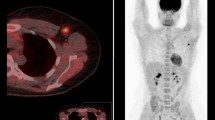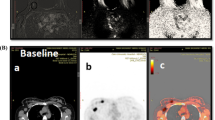Abstract
Purpose
Regional axillary lymph node status has remained the single most independent variable to predict prognosis both in terms of disease recurrence and survival. This study aimed to prospectively assess sequential [18F]fluorodeoxyglucose (FDG) positron emission tomography (PET) findings as early predictors of axillary lymph node response to neoadjuvant chemotherapy in stage II and III breast cancer patients.
Methods
Images were acquired with a PET/CT scanner in 52 patients after administration of FDG (5 MBq/kg) at baseline and after the first, second, third and sixth course of chemotherapy before surgery. Clinical examination and ultrasound (US) were used to assess the size of axillary nodes. Decrease in the standardized uptake value (SUV) with PET corrected or not for partial volume effects was compared to the pathological response.
Results
The sensitivity, specificity and accuracy of axillary node staging was higher with PET (75, 87 and 80%) than with US (50, 83 and 65%), and even more so when PET images were corrected for partial volume effects (86, 83 and 84%). While FDG uptake did not vary much in non-responders, as confirmed by histopathological analysis, it markedly decreased to baseline levels in responders (p < 10−5). Fifty per cent of baseline SUV was considered the best cutoff value to distinguish responders from non-responders. The sensitivity, specificity, negative predictive value and accuracy of FDG PET after one course of chemotherapy were, respectively, 96, 75, 95 and 84%.
Conclusion
The pathological status of regional axillary lymph nodes in stage II and III breast cancer patients could be accurately predicted after one course of neoadjuvant chemotherapy based on FDG PET images.



Similar content being viewed by others
References
Mamounas EP. Overview of National Surgical Adjuvant Breast Project neoadjuvant chemotherapy studies. Semin Oncol 1998;25:31–5.
Pierga JY, Mouret E, Diéras V, Laurence V, Beuzeboc P, Dorval T, et al. Prognostic value of persistent node involvement after neoadjuvant chemotherapy in patients with operable breast cancer. Br J Cancer 2000;83:1480–7.
Rouzier R, Extra JM, Klijanienko J, Falcou MC, Asselain B, Vincent-Salomon A, et al. Incidence and prognostic significance of complete axillary downstaging after primary chemotherapy in breast cancer patients with T1 to T3 tumors and cytologically proven axillary metastatic lymph nodes. J Clin Oncol 2002;20:1304–10.
Prati R, Minami CA, Gornbein JA, Debruhl N, Chung D, Chang HR. Accuracy of clinical evaluation of locally advanced breast cancer in patients receiving neoadjuvant chemotherapy. Cancer 2009;115:1194–202.
Wahl RL, Zasadny K, Helvie M, Hutchins GD, Weber B, Cody R. Metabolic monitoring of breast cancer chemohormonotherapy using positron emission tomography: initial evaluation. J Clin Oncol 1993;11:2101–11.
Rousseau C, Devillers A, Sagan C, Ferrer L, Bridji B, Campion L, et al. Monitoring of early response to neoadjuvant chemotherapy in stage II and III breast cancer by [18F]fluorodeoxyglucose positron emission tomography. J Clin Oncol 2006;24:5366–72.
Bassa P, Kim EE, Inoue T, Wong FC, Korkmaz M, Yang DJ, et al. Evaluation of preoperative chemotherapy using PET with fluorine-18-fluorodeoxyglucose in breast cancer. J Nucl Med 1996;37:931–8.
Mankoff DA, Dunnwald LK, Gralow JR, Ellis GK, Schubert EK, Tseng J, et al. Changes in blood flow and metabolism in locally advanced breast cancer treated with neoadjuvant chemotherapy. J Nucl Med 2003;44:1806–14.
Smith IC, Welch AE, Hutcheon AW, Miller ID, Payne S, Chilcott F, et al. Positron emission tomography using [(18)F]-fluorodeoxy-D-glucose to predict the pathologic response of breast cancer to primary chemotherapy. J Clin Oncol 2000;18:1676–88.
Straver ME, Aukema TS, Valdes Olmos RA, Rutgers EJ, Gilhuijs KG, Schot ME, et al. Feasibility of FDG PET/CT to monitor the response of axillary lymph node metastases to neoadjuvant chemotherapy in breast cancer patients. Eur J Nucl Med Mol Imaging 2010;37:1069–76.
Sobin LH, Wittekind Ch. TNM classification of malignant tumors. 6th ed. New York: Wiley-Liss; 2002.
Rousset OG, Ma Y, Evans AC. Correction for partial volume effects in PET: principles and validation. J Nucl Med 1998;39:904–11.
Ferrer L, Grealou Y, Autret D, et al. A new ImageJ plugin to correct for partial effect volume. Eur J Nucl Med Mol Imaging 2004;31:Suppl 2 (abstract 120).
Soret M, Koulibaly PM, Darcourt J, Buvat I. Partial volume effect correction in SPECT for striatal uptake measurements in patients with neurodegenerative diseases: impact upon patient classification. Eur J Nucl Med Mol Imaging 2006;33:1062–72.
Eisenhauer EA, Therasse P, Bogaerts J, Schwartz LH, Sargent D, Ford R, et al. New response evaluation criteria in solid tumours: revised RECIST guideline (version 1.1). Eur J Cancer 2009;45:228–47.
Sataloff DM, Mason BA, Prestipino AJ, Seinige UL, Lieber CP, Baloch Z. Pathologic response to induction chemotherapy in locally advanced carcinoma of the breast: a determinant of outcome. J Am Coll Surg 1995;180:297–306.
Kaufmann M, Hortobagyi GN, Goldhirsch A, Scholl S, Makris A, Valagussa P, et al. Recommendations from an international expert panel of the use of neoadjuvant (primary) systemic treatment of operable breast cancer: an update. J Clin Oncol 2006;24:1940–9.
Kuerer HM, Newman LA, Buzdar AU, Dhingra K, Hunt KK, Buchholz TA, et al. Pathologic tumor response in the breast following neoadjuvant chemotherapy predicts axillary lymph node status. Cancer J Sci Am 1998;4:230–6.
Gajdos C, Tartter PI, Estabrook A, Gistrak MA, Jaffer S, Bleiweiss IJ. Relationship of clinical and pathologic response to neoadjuvant chemotherapy and outcome of locally advanced breast cancer. J Surg Oncol 2002;80:4–11.
Hennessy BT, Gonzalez-Angulo AM, Hortobagyi GN, Cristofanilli M, Kau SW, Broglio K, et al. Disease-free and overall survival after pathologic complete disease remission of cytologically proven inflammatory breast carcinoma axillary lymph node metastases after primary systemic chemotherapy. Cancer 2006;106:1000–6.
Uematsu T, Kasami M, Watanabe J, Takahashi K, Yamasaki S, Tanaka K, et al. Is lymphovascular invasion degree one of the important factors to predict neoadjuvant chemotherapy efficacy in breast cancer? Breast Cancer 2010 Jun 24 [Epub ahead of print].
Li D, Yao Q, Li L, Chen J. Correlation between hybrid 18F-FDG PET/CT and apoptosis induced by neoadjuvant chemotherapy in breast cancer. Cancer Biol Ther 2007;6:1442–8.
Bruce DM, Evans NT, Heys SD, Needham G, BenYounes H, Mikecz P, et al. Positron emission tomography: 2-deoxy-2-[18F]-fluoro-D-glucose uptake in locally advanced breast cancers. Eur J Surg Oncol 1995;21:280–3.
Jansson T, Westlin JE, Ahlström H, Lilja A, Långström B, Bergh J. Positron emission tomography studies in patients with locally advanced and/or metastatic breast cancer: a method for early therapy evaluation? J Clin Oncol 1995;13:1470–7.
Schelling M, Avril N, Nährig J, Kuhn W, Römer W, Sattler D, et al. Positron emission tomography using [(18)F]fluorodeoxyglucose for monitoring primary chemotherapy in breast cancer. J Clin Oncol 2000;18:1689–95.
Mankoff DA, Dunnwald LK, Gralow JR, Ellis GK, Lawton TJ, Schubert EK, et al. Blood flow and metabolism in locally advanced breast cancer: relationship to response to therapy. J Nucl Med 2002;43:500–9.
Kim SJ, Kim SK, Lee ES, Ro J, Kang S. Predictive value of [18F]FDG PET for pathological response of breast cancer to neo-adjuvant chemotherapy. Ann Oncol 2004;15:1352–7.
Dose Schwarz J, Bader M, Jenicke L, Hemminger G, Jänicke F, Avril N. Early prediction of response to chemotherapy in metastatic breast cancer using sequential 18F-FDG PET. J Nucl Med 2005;46:1144–50.
McDermott GM, Welch A, Staff RT, Gilbert FJ, Schweiger L, Semple SI, et al. Monitoring primary cancer throughout chemotherapy using FDG-PET. Breast Cancer Res Treat 2007;102:75–84.
Berriolo-Riedinger A, Touzery C, Riedinger JM, Toubeau M, Coudert B, Arnould L, et al. [18F]FDG-PET predicts complete pathological response of breast cancer to neoadjuvant chemotherapy. Eur J Nucl Med Mol Imaging 2007;34:1915–24.
Tozaki M, Sakamoto M, Oyama Y, O’uchi T, Kawano N, Suzuki T, et al. Monitoring of early response to neoadjuvant chemotherapy in breast cancer with (1)H MR spectroscopy: comparison to sequential 2-[18F]-fluorodeoxyglucose positron emission tomography. J Magn Reson Imaging 2008;28:420–7.
Duch J, Fuster D, Muñoz M, Fernández PL, Paredes P, Fontanillas M, et al. 18F-FDG PET/CT for early prediction of response to neoadjuvant chemotherapy in breast cancer. Eur J Nucl Med Mol Imaging 2009;36:1551–7.
Kumar A, Kumar R, Seenu V, Gupta SD, Chawla M, Malhotra A, et al. The role of 18F-FDG PET/CT in evaluation of early response to neoadjuvant chemotherapy in patients with locally advanced breast cancer. Eur Radiol 2009;19:1347–57.
Thomas A, Ohlinger R, Hauschild M, Mustea A, Blohmer JU, Kümmel S. Options and limits of surgery after pre-operative chemotherapy in breast cancer. Anticancer Res 2006;26:1677–82.
Dalus K, Rendl G, Rettenbacher L, Pirich C. FDG PET/CT for monitoring response to neoadjuvant chemotherapy in breast cancer patients. Eur J Nucl Med Mol Imaging 2010;37:1992–3.
Chollet P, Amat S, Cure H, de Latour M, Le Bouedec G, Mouret-Reynier MA, et al. Prognostic significance of a complete pathological response after induction chemotherapy in operable breast cancer. Br J Cancer 2002;86:1041–6.
Kuerer HM, Newman LA, Smith TL, Ames FC, Hunt KK, Dhingra K, et al. Clinical course of breast cancer patients with complete pathologic primary tumor and axillary lymph node response to doxorubicin-based neoadjuvant chemotherapy. J Clin Oncol 1999;17:460–9.
Krak NC, Hoekstra OS, Lammertsma AA. Measuring response to chemotherapy in locally advanced breast cancer: methodological considerations. Eur J Nucl Med Mol Imaging 2004;31:S103–11.
Herrada J, Iyer RB, Atkinson EN, Sneige N, Buzdar AU, Hortobagyi GN. Relative value of physical examination, mammography, and breast sonography in evaluating the size of the primary tumor and regional lymph node metastases in women receiving neoadjuvant chemotherapy for locally advanced breast carcinoma. Clin Cancer Res 1997;3:1565–9.
Ollivier L, Balu-Maestro C, Leclère J. Imaging in evaluation of response to neoadjuvant breast cancer treatment. Cancer Imaging 2005;5:27–31.
Martincich L, Montemurro F, De Rosa G, Marra V, Ponzone R, Cirillo S, et al. Monitoring response to primary chemotherapy in breast cancer using dynamic contrast-enhanced magnetic resonance imaging. Breast Cancer Res Treat 2004;83:67–76.
Segara D, Krop IE, Garber JE, Winer E, Harris L, Bellon JR, et al. Does MRI predict pathologic tumor response in women with breast cancer undergoing preoperative chemotherapy? J Surg Oncol 2007;96:474–80.
Javid S, Segara D, Lotfi P, Raza S, Golshan M. Can breast MRI predict axillary lymph node metastasis in women undergoing neoadjuvant chemotherapy. Ann Surg Oncol 2010;17:1841–6.
Harada T, Tanigawa N, Matsuki M, Nohara T, Narabayashi I. Evaluation of lymph node metastases of breast cancer using ultrasmall superparamagnetic iron oxide-enhanced magnetic resonance imaging. Eur J Radiol 2007;63:401–7.
Acknowledgments
The authors’ gratitude goes to the patients of the study, the nuclear medicine technologists at the René Gauducheau, N. Fleury, E. Cerato and M. Vinson. This study was supported by «Conseil Régional des Pays de Loire.»
Conflicts of interest
None.
Author information
Authors and Affiliations
Corresponding author
Additional information
The study has been presented at the 2006 Annual Meeting of the American Society of Clinical Oncology, Proceedings, 2–6 June, Atlanta, USA. The study has been presented at the 2006 53rd Annual Meeting of the Society of Nuclear Medicine, Oral Presentation, 3–7 June, San Diego, USA.
Rights and permissions
About this article
Cite this article
Rousseau, C., Devillers, A., Campone, M. et al. FDG PET evaluation of early axillary lymph node response to neoadjuvant chemotherapy in stage II and III breast cancer patients. Eur J Nucl Med Mol Imaging 38, 1029–1036 (2011). https://doi.org/10.1007/s00259-011-1735-y
Received:
Accepted:
Published:
Issue Date:
DOI: https://doi.org/10.1007/s00259-011-1735-y




